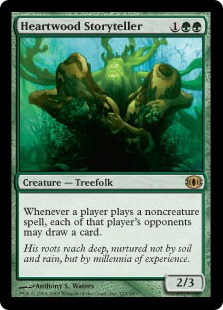While there innumerable different ways to construct a Magic deck, almost all have one thing in common: the desire to win. Admittedly, there are many decks crafted with the objective of having fun more than winning, and there is an even smaller subset of decks designed around simply causing chaos. Winning, though, is generally the idea.
How you get to that win is entirely up to your play style.
Some prefer to win a soon as possible:
“My turn one, I reveal 2 Chancellor of the Tangles. I play a Mountain and a Lotus Petal. I sacrifice the Petal for Green, and cast Channel I spent 19 life and cast Fireball. X is 20. GG.”
Congrats! You were just on the receiving end of one iteration of a very old turn one kill staple. (There are many others; half of Legacy and Vintage play is based around utilizing or stopping them.) Even if a first turn win isn’t feasible, there are many players who feel that any deck worth its salt should win in around six or so turns.
Others drag games out into flip-the-table induced tedium:
“Did you pay the extra one for Rhystic Study? How about the Spelltithe Enforcer? Are you going to pay two or take the damage from Soul Barrier? Alright, I tap my land with Sunken Field to have you pay one or it’s countered. Alright, my turn? I cast Stasis…”
And then there are those who announce they’re casting Grip of Chaos just to see people’s reactions – which is usually somewhere between a smirk, a facepalm, and berserker rage.
The thing is, any and all of these examples are completely legitimate ways to play the game. Magic is so wide and varied in terms of play styles, format choices, and number of opponents, that there is a niche concept somewhere that will appeal to even the most eccentric. It’s a testament to the game’s tenacity that it can withstand continual changes every year while still offering people a multitude of style options. Even if the player base is still largely homogenous [Sorry, but it’s true. It’s diversifying, but it’s a slow process.], there ultimately is enough variety for just about anyone.
One such style you see is an “Everybody Benefits” style of deck, often called a ‘Group Hug’. It offers up a lot of cards that clearly benefit everyone, such as some of the Join Forces cards. Of course, as Rosewater’s recent article on lenticular design points out, these are the sort of cards that can serve a dual purpose, depending on a player’s experience.
Take for example, Prosperity. On the surface, a newer player might not like that because it allows everyone to benefit from drawing cards. More experienced players see that as a potential win card if paired correctly.
Group Hug Commander decks operate in a space between those two mindsets. To these decks, Prosperity could be a win condition, or it can be a great political maneuver by letting everyone benefit from your stuff. The idea goes that if everyone gets to draw cards, gain life, get Saproling tokens, and so on, it’s far less likely that another player is going to focus their attention on you. Group Hug decks exist as part political, part entertainment, and part kumbaya-ing you into oblivion. It’s an esoteric deck idea, and it requires the right cards. So, let’s look at one.
Today we have: Heartwood Storyteller

Name: Heartwood Storyteller
Edition: Future Sight
Rarity: Rare
Focus: Card Draw
Highlights: Before Edric, Spymaster of Trest came along, there was the Heartwood Storyteller. Edric certainly gets more of the attention these days, as his ability is far more focused and political – only the person attacking gets to draw, and it’s based on dealing combat damage to a player.
Edric is more offense-based, however. By contrast, the Storyteller just wants to sit back and tell you a tale or two. This card’s ability is far more passive, and it’s something everyone can benefit from.
It’s not a carte blanche effect, though. The Storyteller’s main benefit is to semi-subtly punish players who aren’t putting out creatures – something pretty common in Commander. It also pushes players into a more creature-based offensive if they wish to avoid letting their opponent benefit.
Interestingly, because of its potential to be sporadically helpful to everyone, Heartwood Storyteller doesn’t exude a lot of threat on the board. The 2/3 frame doesn’t hurt, though, avoiding easily pingable deaths. (We suppose that’s probably something he learned along the way.) Instead, the Storyteller operates as an oscillating Howling Mine of sorts, and while there are some players that take issue with mass card acceleration, in a Commander game, there are usually more dangerous things afoot than an ancient Treefolk.
Keep an eye out for us to be regularly featuring other more accessible-but-worth-it Commander cards going forward. In the meantime, we’ll keep the light on for you.
![]()
You can discuss this article over on our social media!
Do you have a particular Commander card to suggest for us to shine a future Spotlight on? You can send suggestions to ryan@cardboardrepublic.com
